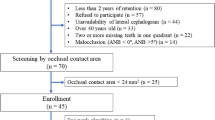Abstract
Purpose
Since prehistory, changes of the facial skeleton have been related to the modification of diet. More recent studies have shown changes in the morphology of the mandible and maxilla due to variations of strain during mastication. The temporal muscle (TM) is a strong masticatory muscle, with its insertions extending through the temporal fossa. Our objective is to observe the relations between the TM and the lateral orbital wall (LOW) which could indicate an influence of mastication on the shape of the LOW.
Methods
We conducted a retrospective study using 100 CT scans. The length of the lateral orbital wall (LLOW), the angle between LOW and the medial orbital wall (MOW), the cross-sectional areas of LOW and of the TMs were measured on both sides of each CT scan. The correlation between TMs and other three parameters was studied by Pearson correlations.
Results
A correlation was found between TMs and LOWs, a lower with LLOW, and a very weak and negative correlation between LOW/MOW angle.
Conclusions
Anatomical knowledge about TM and investigation of masticatory strains lead us to think that mastication have minimal effect on the morphology of the LOW, only on the frontal process of zygomatic. This may explain, in part, why the LOW is the strongest wall of the orbit.

Similar content being viewed by others
References
Bénateau H, Labbé D, Rigot-Jolivet M, Elissalde JM, Salamé E (2002) The temporal periosteum: anatomical study and surgical implications. Annales de chirurgie plastique esthetique 47(3):189–195
Benington PC, Gardener JE, Hunt NP (1999) Masseter muscle volume measured using ultrasonography and its relationship with facial morphology. Eur J Orthod 21:659–670
Carlson DS, Van Gerven DP (1977) Masticatory function and post-Pleistocene evolution in Nubia. Am J Phys Anthropol 46:495–506
Ducasse A (2007) Surgical orbital anatomy. Oculoplastics and orbit. Springer, New York, pp 73–97
Engström C, Kiliaridis S, Thilander B (1986) The relationship between masticatory function and craniofacial morphology. II. A histological study in the growing rat fed a soft diet. Eur J Orthod 8:271–279
Enlow DH (1966) A comparative study of facial growth in Homo and Macaca. Am J Phys Anthropol 24:293–307
Hylander WL, Johnson KR, Picq PG (1991) Masticatory-stress hypotheses and the supraorbital region of primates. Am J Phys Anthropol 86:1–36
Ingervall B, Bitsanis E (1987) A pilot study of the effect of masticatory muscle training on facial growth in long-face children. Eur J Orthod 9:15–23
Janovic A, Saveljic I, Vukicevic A, Nikolic D, Rakocevic Z, Jovicic G (2015) Occlusal load distribution through the cortical and trabecular bone of the human mid-facial skeleton in natural dentition: a three-dimensional finite element study. Ann Anat Anat Anz 197:16–23
Lieberman DE, Krovitz GE, Yates FW, Devlin M, Claire MS (2004) Effects of food processing on masticatory strain and craniofacial growth in a retrognathic face. J Hum Evol 46:655–677
Pakdel AR, Whyne CM, Fialkov JA (2017) Structural biomechanics of the craniomaxillofacial skeleton under maximal masticatory loading: inferences and critical analysis based on a validated computational model. J Plast Reconstr Aesthet Surg 70:842–850
Prado FB, Freire AR, Cláudia Rossi A, Ledogar JA, Smith AL, Dechow PC (2016) Review of in vivo bone strain studies and finite element models of the zygomatic complex in humans and nonhuman primates: implications for clinical research and practice. Anat Rec 299:1753–1778
Sella-Tunis T, Pokhojaev A, Sarig R, O’Higgins P, May H (2018) Human mandibular shape is associated with masticatory muscle force. Sci Rep 8:6042
Sicher H, Tandler J (1928) Anatomie für zahnärzte. J. Springer, Berlin
Toro-Ibacache V, Zapata Muñoz V, O’Higgins P (2016) The relationship between skull morphology, masticatory muscle force and cranial skeletal deformation during biting. Ann Anat Anat Anz 203:59–68
Van Spronsen PH, Weijs WA, Valk J, Prahl-Andersen B, van Ginkel FC (1992) A comparison of jaw muscle cross-sections of long-face and normal adults. J Dent Res 71:1279–1285
Wachtler F, Jacob M (1986) Origin and development of the cranial skeletal muscles. Bibliotheca Anatomica 29:24–46
Weijs WA, Hillen B (1985) Cross-sectional areas and estimated intrinsic strength of the human jaw muscles. Acta Morphol Neerl Scand 23:267–274
Wolff J (1986) The law of bone remodelling. Springer, Berlin
Wong A, Woods M, Stella D (2016) Three-dimensional computed tomographic assessment of mandibular muscles in growing subjects with different vertical facial patterns. Aust Orthod J 32:2–17
Zink KD, Lieberman DE (2016) Impact of meat and lower Palaeolithic food processing techniques on chewing in humans. Nature 531:500–503
Author information
Authors and Affiliations
Contributions
MA: project development, data collection, manuscript writing. JMF: manuscript writing. NG: data collection. KC: data collection. CC: project development. LG: project development, manuscript writing.
Corresponding author
Ethics declarations
Conflict of interest
The authors declare no conflict of interest.
Additional information
Publisher's Note
Springer Nature remains neutral with regard to jurisdictional claims in published maps and institutional affiliations.
Rights and permissions
About this article
Cite this article
Arnaud-Brachet, M., Foletti, J.M., Graillon, N. et al. Could mastication modify the shape of the orbit? A scannographic study in humans. Surg Radiol Anat 42, 63–67 (2020). https://doi.org/10.1007/s00276-019-02315-7
Received:
Accepted:
Published:
Issue Date:
DOI: https://doi.org/10.1007/s00276-019-02315-7




